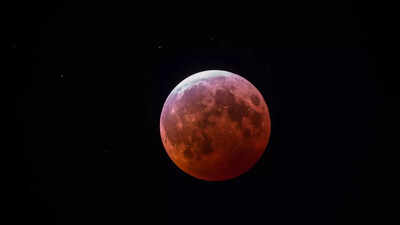Trending
Lunar Eclipse 2025: When and Where to see it? Visibility in India, Safety tips on how to watch it
This isn’t just any eclipse; it will transform the Moon into a stunning red hue, a phenomenon known as the “Blood Moon.” It’s a rare and mesmerizing sight that stargazers worldwide are eagerly waiting for. However, there’s a catch: while much of the world will get a front-row seat to this astronomical wonder, India will miss out on this awe-inspiring display.
Today, March 14, 2025, brings an event in the sky that will leave everyone talking– the first total lunar eclipse of the year. This isn’t just any eclipse; it will transform the Moon into a stunning red hue, a phenomenon known as the “Blood Moon.” It’s a rare and mesmerizing sight that stargazers worldwide are eagerly waiting for. However, there’s a catch: while much of the world will get a front-row seat to this astronomical wonder, India will miss out on this awe-inspiring display.
Still, whether you’re an astronomy enthusiast or just enjoy watching the night sky, this total lunar eclipse is set to be one of the biggest events of 2025. But what makes it so special? Let’s take a closer look at the details of this eclipse, how to see it, and what to expect from this amazing sight.
What is a total lunar eclipse?

While lunar eclipses are relatively common, a total lunar eclipse that gives the Moon such a vivid red colour is still a special occurrence. During a total lunar eclipse, the Moon turns red or orange because Earth's atmosphere scatters shorter wavelengths (blue/green) and lets red light pass through and hit the Moon. Throughout history, lunar eclipses have been associated with myths, legends, and omens in various cultures — often seen as powerful cosmic events.
When and where can you see the 2025 eclipse?
Note: This list is compiled from information provided by online media sources.
Here’s when the eclipse will take place and what you can expect to see at each phase:
Timings of the lunar eclipse (in IST and EDT):
First Contact with Penumbra (Partial shadow begins): 09:29 AM IST (March 14, 2025)
First Contact with Umbra (Total shadow begins): 10:41 AM IST
Total Phase Begins (The Moon enters full shadow): 11:57 AM IST
Maximum Eclipse (The Moon is fully in the Earth’s shadow): 12:29 PM IST
Total Phase Ends (The Moon starts moving out of the shadow): 01:01 PM IST
Last Contact with Umbra (End of the total shadow phase): 02:17 PM IST
Last Contact with Penumbra (End of partial shadow): 03:29 PM IST
For those in the U.S., Western Europe, and parts of the Atlantic, the eclipse began around 11:57 PM EDT on March 13, 2025, and continued into the early hours of March 14. This timing gives people the chance to watch the eclipse overnight, making it an exciting event for stargazers to stay up late and enjoy nature’s sight.

Why does the Moon turn red? The science behind the blood moon
When the Moon moves into Earth’s shadow during a total lunar eclipse, it doesn’t just go dark. Instead, Earth’s atmosphere bends sunlight, filtering out blue light and letting only red and orange tones reach the Moon. This effect, called Rayleigh scattering, is the same reason the sky looks blue during the day.
That’s why, during an eclipse, the Moon turns a deep red– earning it the name "Blood Moon." It’s a breathtaking sight that has fascinated skywatchers for centuries. But beyond the science, it’s a moment of pure wonder– a reminder of just how vast and incredible our universe really is.
Will you be able to see it from India?
Unfortunately, India won’t get to see the lunar eclipse on March 14, 2025. Since the eclipse happens during the day in India, the Moon will be below the horizon or lost in daylight, making it impossible to witness. However, skywatchers in North America, Western Europe, and parts of the Atlantic Ocean will have a great view.
Even though India misses out on the Blood Moon, there’s no need to feel left out! Live streams and online updates will let viewers in India follow the event in real time and still be part of the excitement.
How to safely watch the lunar eclipse
One of the great things about lunar eclipses is that they are completely safe to observe with the naked eye. Unlike solar eclipses, which require special glasses to avoid eye damage, lunar eclipses pose no risk to your vision. All you need to do is step outside and enjoy the show. But if you want to make the experience even better, here are some tips:
Pick the right spot: Head to an open area with a clear view of the sky. Stay away from city lights and tall buildings to avoid obstructions. A park or an open field is perfect.
Dress for comfort: If it’s a cold night, layer up! Since lunar eclipses can last for hours, staying warm will make the experience much better.

Enhance your view: While you can see the eclipse with your own eyes, using binoculars or a telescope will reveal details like craters and shadows, making it even more fascinating.
Stay in the loop: Check astronomy websites for live updates and streaming options. If the weather doesn’t cooperate, you can still catch the eclipse through online broadcasts from observatories and space enthusiasts.
The cultural and spiritual significance of lunar eclipses
Lunar eclipses have held great significance across different cultures for centuries. In ancient times, eclipses were often seen as omens or signs of important events. In some cultures, a lunar eclipse was believed to be a time when cosmic forces aligned, and they were associated with both positive and negative energy.
In India, the lunar eclipse (known as “Chandra Grahan”) has spiritual and cultural importance. Many people believe that during the eclipse, the Moon’s energy is temporarily altered, and as a result, it’s a time for reflection and cleansing. Some people fast or participate in rituals during the eclipse, while others avoid certain activities.
Globally, lunar eclipses are also seen as times of transformation. In astrology, they are believed to signify significant life changes or emotional breakthroughs, especially for individuals whose zodiac signs are affected by the eclipse. This makes it not only an exciting event to observe but also a symbolic one for those who follow astrological interpretations.
Why are lunar eclipses so special?
While solar eclipses often steal the spotlight, lunar eclipses hold their own unique charm. Unlike solar eclipses, which are visible only in a narrow path on Earth, lunar eclipses can be seen by anyone on the night side of the Earth. This makes them more accessible and often easier to view.
Additionally, lunar eclipses last much longer than solar eclipses. While the total phase of a solar eclipse may only last a few minutes, the total phase of a lunar eclipse can last for over an hour, offering ample time to observe and appreciate the event. This extended duration makes lunar eclipses a more leisurely and enjoyable experience for sky-watchers.
In a nutshell, it’s clear that this total lunar eclipse will be one of the most memorable astronomical events of the year. Even though India won’t be able to see it, there will still be plenty of opportunities for people in other parts of the world to witness the striking transformation of the Moon into a Blood Moon.
Whether you’re a space expert or just someone who loves looking at the night sky, this event is a chance to enjoy the beauty of the universe. If you're in a place where the eclipse is visible, grab a blanket, find a quiet spot, and watch as the Moon changes colour. The Blood Moon of 2025 will surely be a sight to remember!
End of Article
FOLLOW US ON SOCIAL MEDIA
Visual Stories
Tired of too many ads?










